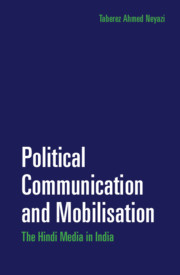Book contents
- Frontmatter
- Dedication
- Contents
- List of Figures, Tables and Maps
- Preface
- Acknowledgements
- Chapter 1 Introduction: Political Communication and Mobilisation in India
- Chapter 2 Under Colonial Rule: Mobilisation in the Hindi and English Press
- Chapter 3 Media and Mobilisation in Independent India
- Chapter 4 Localisation, Grassroots Mobilisation and Hindi News Media
- Chapter 5 Political Economy of the Hindi Press
- Chapter 6 The Hybrid Media System, Anti-corruption Movement and Political Mobilisation
- Chapter 7 Agenda-setting and Mobilisation in a Hybrid Media Environment
- Chapter 8 Conclusion: Politics, Power and Mobilisation in Digital India
- Bibliography
- Index
Chapter 6 - The Hybrid Media System, Anti-corruption Movement and Political Mobilisation
Published online by Cambridge University Press: 17 August 2019
- Frontmatter
- Dedication
- Contents
- List of Figures, Tables and Maps
- Preface
- Acknowledgements
- Chapter 1 Introduction: Political Communication and Mobilisation in India
- Chapter 2 Under Colonial Rule: Mobilisation in the Hindi and English Press
- Chapter 3 Media and Mobilisation in Independent India
- Chapter 4 Localisation, Grassroots Mobilisation and Hindi News Media
- Chapter 5 Political Economy of the Hindi Press
- Chapter 6 The Hybrid Media System, Anti-corruption Movement and Political Mobilisation
- Chapter 7 Agenda-setting and Mobilisation in a Hybrid Media Environment
- Chapter 8 Conclusion: Politics, Power and Mobilisation in Digital India
- Bibliography
- Index
Summary
Thus far in this book, I have focused on traditional media and the ways in which they have affected political and social mobilisation in contemporary India. This and the following chapter move on to analyse the transformation in the process of political communication and mobilisation after the emergence of new media. In these chapters, I show how new information networks have transformed the dynamics of citizens’ participation and supplemented the role of traditional media and face-to-face interaction, leading to the emergence of what Andrew Chadwick (2011, 2013) called a ‘hybrid’ media system. Political communication now takes place in a more complex hybrid space in which both traditional and newer media are utilised by a diverse array of actors such as political parties, protest movements, and professional news organisations to engage citizens and to influence public opinion and the political agenda.
Several studies have shown the ways in which the internet has transformed democratic politics (Chadwick, 2006; Hindman, 2008; Howard, 2005, 2010; Loader and Mercea, 2012; Mossberger, Tolbert and McNeal, 2007). The WikiLeaks online disclosure of US foreign policy demonstrated the disruption caused by social media, which is now forcing the mainstream news media to turn to political blogs and citizen users for material. Such disruption, according to Loader and Mercea (2012), has enabled citizens to discuss and share political information and ‘critically monitor the actions of governments and corporate interests’ (5) with friends and networked citizens. The rise of the internet also resulted in further fragmentation of media channels and led Bennett and Iyengar (2008) to pronounce the beginning of a new era of ‘minimal media effects’. At the same time, the uneven level of access by different social groups to new media, a phenomenon known as the digital divide, has raised concerns regarding the limitations of its democratic potential. I propose that instead of focusing exclusively on either online media or traditional media, scholars should see the complexity as a result of a hybrid media environment, an environment in which traditional media continue to occupy an important place along with new media and face-to-face interactions. However, the hybrid media environment of India differs from the media environments in advanced economies in which most citizens access the internet.
- Type
- Chapter
- Information
- Political Communication and MobilisationThe Hindi Media in India, pp. 137 - 160Publisher: Cambridge University PressPrint publication year: 2017



